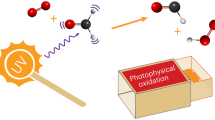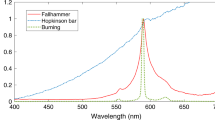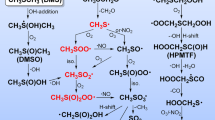Abstract
THE spectrum of the sulphur dioxide afterglow was first investigated in detail by Gaydon1, who reported that it appeared to be continuous over its entire range from 2400 Å into the visible, apart from some weak bands above 3800 Å which are now known to arise from the (0,0,0) and (0,1,0) levels of the 3B1 state of SO2 (refs. 2 and 3). More recently, Herman et al.4 have investigated the afterglow at low pressures and found no evidence of banded structure; they confirmed Gaydon's view that the afterglow was due to the chemiluminescent combination of O and SO, but did not establish whether it required a third body.
This is a preview of subscription content, access via your institution
Access options
Subscribe to this journal
Receive 51 print issues and online access
$199.00 per year
only $3.90 per issue
Buy this article
- Purchase on Springer Link
- Instant access to full article PDF
Prices may be subject to local taxes which are calculated during checkout
Similar content being viewed by others
References
Gaydon, A. G., Proc. Roy. Soc., A, 146, 901 (1934).
Gaydon, A. G., The Spectroscopy of Flames (Chapman and Hall, London, 1957).
Merer, A. J., Disc. Farad. Soc., 35, 127 (1963).
Herman, L., Akriche, J., and Grenat, H., J. Quant. Spec. and Rad. Trans., 2, 215 (1962).
Clyne, M. A. A., and Thrush, B. A., Proc. Roy. Soc., A, 269, 404 (1962).
Doherty, G., and Jonathan, N., Disc. Farad. Soc., 37 (1964).
Broida, H. P., Schiff, H. I., and Sugden, T. M., Trans. Farad. Soc., 57, 259 (1961).
Metropolis, N., Phys. Rev., 60, 283, 295 (1941).
Parker, C. A., and Hatchard, C. G., Trans. Farad. Soc., 59, 284 (1963).
Greaves, J. C., and Garvin, D., J. Chem. Phys., 30, 348 (1959); ASTIA Tech. Note AD201510 (1958).
Clyne, M. A. A., Thrush, B. A., and Wayne, R. P., Trans. Farad. Soc., 60, 359 (1964).
Setser, D. W., and Thrush, B. A., Nature, 200, 864 (1963).
Greenough, K. F., and Duncan, A. B. F., J. Amer. Chem. Soc., 83, 555 (1961).
Neuberger, D., and Duncan, A. B. F., J. Chem. Phys., 22, 1693 (1954).
Mulliken, R. S., Canad. J. Chem., 36, 10 (1958).
Polanyi, J. C., J. Quant. Spec. and Rad. Trans., 3, 471 (1963).
Author information
Authors and Affiliations
Rights and permissions
About this article
Cite this article
HALSTEAD, C., THRUSH, B. Chemiluminescent Reactions of SO with O and with O3. Nature 204, 992–993 (1964). https://doi.org/10.1038/204992a0
Issue Date:
DOI: https://doi.org/10.1038/204992a0
This article is cited by
-
The photophysics and photochemistry of SO2
Reviews of Chemical Intermediates (1980)
Comments
By submitting a comment you agree to abide by our Terms and Community Guidelines. If you find something abusive or that does not comply with our terms or guidelines please flag it as inappropriate.



